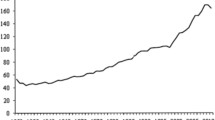Abstract
Reserves and institutional asset managers have to constantly monitor and assess risk-return trade-offs in the markets where they invest. Among the various tools and indicators that they employ, understanding the balance sheet strength of commercial banks is indispensable. This is because of the role of banks as credit intermediaries for financing economic activity and their important function in the payment and market infrastructures for financial transactions. As central banks have embarked on many, new unconventional monetary policy measures, it is important to ask what the impact on commercial banks is, and whether this enhances or inhibits their traditional credit intermediary role. This chapter examines these questions and considers what hidden risks might be building up as central banks accumulate assets.
Access this chapter
Tax calculation will be finalised at checkout
Purchases are for personal use only
Similar content being viewed by others
Notes
- 1.
See also Chap. 7.
References
Bank for International Settlements. (2018). Financial stability implications of a prolonged period of low interest rates (No 61. July).
Brunnermeier, M., & Koby, Y. (2019). The reversal interest rate (IMES Discussion Paper Series 19-E-06, Institute for Monetary and Economic Studies, Bank of Japan).
Choulet C (2015) QE and bank balance sheets: The American experience. Conjoncture, BNP Paribas. July-August.
Chui, M., Kuruc, E., & Turner, P. (2018). Leverage and currency mismatches: Non-financial companies in the emerging markets. The World Economy, 41(12), 3269–3287. https://doi.org/10.1111/twec.12627.
Danthine, J. –P. (2017). Negative interest rates in Switzerland: What have we learned? Paris School of Economics (Working Paper no 2017-35).
European Parliament. (2018). Excess liquidity and bank lending in the euro area. Monetary Policy Dialogue.
Gray, S. (2011). Central bank balances and reserve requirements (IMF Working Paper no 11/36. February).
Ihring, J., Meade, E., & Weinbach, G. (2015). Rewriting monetary policy 101: What’s the Fed’s preferred post-crisis approach to raising interest rates? Journal of Economic Perspectives, 29(4), 177–198.
Kwan, K. (2000). The 1997 financial crisis and governance: The case of South Korea (Working Paper 272, Kellogg Institute. March).
Mohanty, M., & Turner, P. (2006). Foreign exchange reserve accumulation in emerging markets: What are the domestic implications? BIS Quarterly Review, September.
Ramaswamy, R. (2018). A decade after Lehman: Taking stock of quantitative easing and regulation (Cambridge Working Paper Economics 1824. April).
Rule, G. (2015). Understanding the central bank balance sheet. In Centre for Central Banking Studies. London: Bank of England.
Santiprabhob, V. (2017). Monetary policy challenges during the great transition: Perspectives from an emerging market central bank. In Speech by the Governor of Bank of Thailand at the Official Monetary and Financial Institutions Forum, London. 10 January.
Author information
Authors and Affiliations
Corresponding author
Editor information
Editors and Affiliations
Rights and permissions
Copyright information
© 2020 Springer Nature Switzerland AG
About this chapter
Cite this chapter
Ramaswamy, S., Turner, P. (2020). Expansion and Contraction of Central Bank Balance Sheets: Implications for Commercial Banks. In: Bjorheim, J. (eds) Asset Management at Central Banks and Monetary Authorities. Springer, Cham. https://doi.org/10.1007/978-3-030-43457-1_9
Download citation
DOI: https://doi.org/10.1007/978-3-030-43457-1_9
Published:
Publisher Name: Springer, Cham
Print ISBN: 978-3-030-43456-4
Online ISBN: 978-3-030-43457-1
eBook Packages: Economics and FinanceEconomics and Finance (R0)




